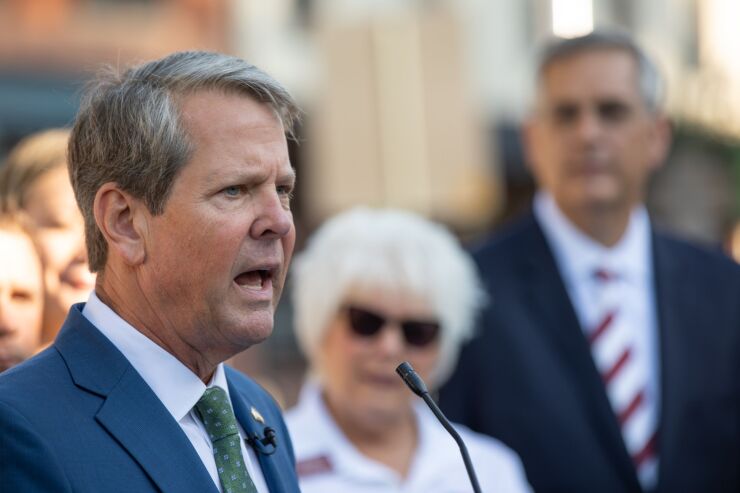Following a strong summer collections season, Georgia's Department of Revenue recently announced revised revenue predictions for the fiscal year 2022 that beat the previous year by more than $6 billion.
The department
That means the state collected $6.8 billion more than it spent in the fiscal year, up from $4.45 billion, according to the Georgia Budget and Policy Institute think tank.

The back-to-back surpluses are in line with similarly strong economic rebounds witnessed in local economies nationwide following the pandemic.
Gov. Brian Kemp used last year's surplus to persuade fellow Republicans who control the legislature to pass tax breaks as well as a $1.58 billion payment into the state's Revenue Shortfall Reserve account, bringing it to a record level of $5.2 billion.
With a gubernatorial election around the corner, the debate about what to do with the new surplus is taking on renewed importance.
Democratic nominee Stacey Abrams, who lags by only a few points in the most recent statewide polls after narrowly losing the 2018 race to Kemp, has put forward a spending plan that even under lower-revenue scenarios would funnel money in part from the Revenue Shortfall Reserve towards social programs and state agencies.
In a campaign speech Tuesday, Abrams called on the governor to buck longstanding low-tax, low-spending policies of austerity, and utilize surplus funds for social initiatives.
According to the Georgia Budget and Policy Institute, which advocates for "a more inclusive economy," the fiscally conservative spending policies of three consecutive administrations harmed the state's public service sector even as it filled the reserve account.
"Setting the revenue estimate is a policy decision,"
In fiscal year 2023, which started July 1, the state will spend about $121 less per resident and $1.3 billion less overall than it did before the Great Recession in 2008, when Georgia instituted austerity measures that have never quite gone away, according to the report.
Following the market crash in late 2007, Georgia was slower to rebound than most other states , according to Georgia State University's Center for State and Local Finance in
According to the Georgia State researchers, by 2012 "real per capita gross state product had only reached 95 percent of its 2007 economic output," leaving Georgia with the eighth slowest recovery in the nation, largely due to the state's disproportionate reliance on sales and corporate tax earnings that were slow to return.
By 2014, however, buoyed by federal relief funds, a return of private sector employment, and a general uptick in activity, the economy began a strong rebound and over the next few years reached and exceeded pre-recession levels of revenue — but not spending.
By then, Gov. Nathan Deal, who had replaced Sonny Perdue in 2011, opted to continue his predecessor's policy of austerity over two terms in office, with annual surpluses funneled to the Revenue Shortfall Reserve, which had been drawn down to $100 million from $1.2 billion during the first year of the recession.
With $5.2 billion it is larger than ever and gives the state ample cushioning, the Georgia Budget and Policy Institute argues.
Abandoning the general policy of the last decade and reinvesting in Georgia's public workforce, which didn't recover from the Great Recession on par with local governments in the rest of the nation, should be a key initiative, the institute says.
Georgia's state workforce stood at 101,000 state employees in 2008, according to the institute. By 2018 it was 81,000, and by 2021, 76,000, an overall reduction of nearly one-third.

"In recent years, this trend has only accelerated," the report said.
Fiscal year 2022 followed much of the same, according to data from Georgia's Department for Administrative Services. The most recent official overview of the public workforce estimated that the executive branch workforce alone dropped by 16.7% over the last decade.
"In FY21, the full-time employee population shrank again," it continued, "this time by 5%. The 8.7% decrease over the last two fiscal years represents the steepest decrease since 2008-2010."
The newly announced revenue projections create a multi-billion dollar question for state officials ahead of an election featuring contrasting spending philosophies, whatever the specific decision made in terms of the state's revenue surplus.
Georgia, rated triple-A across the board, "does a lot of things right in terms of managing its credit profile," according to Eric Kim, senior director and primary rating analyst for Georgia at Fitch Ratings.
"There are a lot of different factors" at work when establishing a state's continued creditworthiness, in addition to the amount of capital reserves it has on hand.
"Part of that is having solid reserve levels to deal with potential economic volatility, part of it is also having pretty steady and strong economic growth," he said. "Part of it's keeping its liabilities at a relatively low level, and very well managed."
Kim added that Georgia's government in the past quickly and decisively responded to economic crisis, "activating the levers of managing its spending, cutting back on spending, and tapping into reserves" when it was necessary. "That's just been the makeup and approach for the state for managing its budget," he said.
While Georgia's many tools for tapering spending have worked in the past, the state does "tend to turn towards cutting back on spending" and using reserve funds, rather than "increasing revenues" as seen in other states, according to Kim.
Spending decisions are dependent on the political environment and despite "potentially different choices in terms of where the dollars go," Kim said he believes the state will "maintain a generally balanced or responsible approach" to debt and finances no matter who is in power.
"The choices that legislators and governors make about how much they want to spend on things like education and health care, are really choices each state is going to make on its own," Kim said.
Georgia had $10.17 billion of outstanding GO bond debt as of June 30, according to the official statement for





